
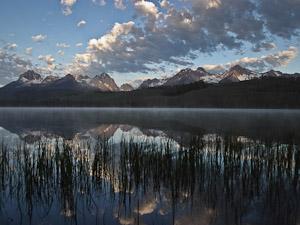
For more than sixty of her ninety-two years, Viola Anglin has owned and operated the Tendoy Store, but those decades have come with unexpected and unwelcome change. Anglin misses the long-ago mornings when salmon fishermen swarmed her wares, buying salmon eggs and filling up on enough calories to sustain them during days casting lines on the Lemhi.
“I was an angry old lady when the salmon fishing was no more,” she said. “I had loved it and made a terrific living in those days. But when it was gone, it was gone.”
The Lemhi is a key tributary of the Salmon River, named for the deluge of salmon and steelhead trout that once returned to central Idaho each summer from the Pacific Ocean. For thousands of years, salmon have been the beating heart of Idaho. They have fed families, boosted the economy, challenged determined anglers, nourished the bodies and spirits of Native Americans, and have been the ecological cornerstone of the state’s treasured wild places.
Scientists estimate that several million salmon and steelhead once returned every year to the Snake River and its largest tributaries, the Clearwater and Salmon rivers. By the 1950s, after decades of habitat destruction, industrial over-fishing and dam building on the Columbia River, wild salmon and steelhead returning to the Snake River basin had already dropped to 200,000 annually. By the 1970s, after construction of four dams on the lower Snake River that further impeded migration to and from the Pacific, populations plummeted.
Wild salmon now return to Idaho at a rate of less than 2 percent of their historic vigor, and this tragic decline has had an unmistakable impact on the state’s people and places. From its mountains to its deserts, and across all its socioeconomic strata, Idaho is a diminished place without salmon.
“The salmon fishing on the Lemhi has been terrific for the Indians and for the white people. I remember when fish kept the people at (the towns of) Gilmore and Leadore alive, back during the Depression. My memories of the Lemhi River are wonderful, back in the old days when we knew all the holes and all the places to fish.”
Between 1990 and 1999, only twenty-two sockeye salmon returned to Redfish Lake in Central Idaho, and an average of 7,200 wild spring/summer chinook salmon returned each year to the entire Snake River Basin, where 2.5 million of these iconic wild fish once flourished.
Idaho’s salmon populations trend like a waterfall, pouring over the edge of the twentieth century.
A Noah's Ark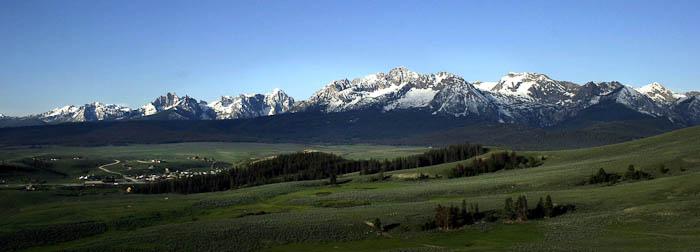
Not far to the east above the Tendoy Store is the 7,373-foot Lemhi Pass, where Meriwether Lewis became the first white American to cross the Continental Divide in August 1805. Having traveled ahead of the rest of the Lewis and Clark expedition, Lewis was in search of the Shoshone Indians, who called themselves Agai Dika, which means ‘salmon eaters.’ Lewis hoped the Indians could provide horses to aid with further travel.
Upon reaching the pass on the spine of the Bitterroot Mountains Lewis wrote that he saw “immense ranges of high mountains still to the west of us with their tops partially covered with snow.” He was looking into the rugged and wild Salmon River country of Idaho, much of it as remote and undeveloped now as it was then.
Downstream along the Lemhi and Salmon rivers, past the present-day town of Salmon, the Salmon River’s canyon began to constrict, and the river developed a foamy, frothy character. The rapids, coupled with the canyon’s sheer rock walls, convinced Lewis and Clark to search for a safer route to the Pacific, and they traveled back over the mountains, north into what is now Montana, before crossing the Bitterroots once more into the headwaters of Idaho’s Clearwater River.
The party became disoriented in the high, densely forested mountains but eventually stumbled into a Nez Perce camp on a plateau above the Clearwater. Exhausted, famished and near death, they were welcomed by the Nez Perce with a feast of dried salmon, buffalo and bread. From that time forward, salmon helped sustain the expedition on its voyage to the Pacific.
Now, two hundred years after the arrival of Lewis and Clark, central Idaho remains pristine and rugged, much of the country too remote and the terrain too difficult for road or dam construction. Dubbed by early settlers “The River of No Return,” the Salmon was only navigable downstream, and only then by skilled boatmen who floated thirty-two-foot scows full of equipment and wares from the city of Salmon 170 miles to Riggins and, beyond, to Lewiston and Clarkston at the confluence of the Snake and Clearwater rivers.
Because of its inaccessibility, central Idaho and its key rivers – the Salmon, Middle Fork of the Salmon, South Fork of the Salmon, Lochsa and Selway – remain wild and pristine compared with other lands and waters in the continental United States. With passage of the Wilderness Act in 1964 and the Wild and Scenic Rivers Act in 1968, much of the country was also eventually given the highest levels of federal protection. The 2.4 million-acre Frank Church-River of No Return Wilderness Area includes the entirety of the Middle Fork of the Salmon River and many of its key tributaries, as well as seventy-five miles of the main Salmon River. The 1.3 million-acre Selway-Bitterroot Wilderness Area contains most of the Selway River and its tributaries. The Middle and main forks of the Salmon, Lochsa, Selway and Middle Fork of the Clearwater rivers are preserved as national treasures with Wild and Scenic protections.
Idaho’s inaccessibility combined with federal protections means the heart of the state boasts clear, cold rivers unobstructed by the impacts of dams – ideal spawning and nursery habitat for wild salmon. Idaho is a Noah’s Ark for salmon in a world confronted with global warming, and the majority of fisheries scientists agree that the only way to return wild, self-sustaining populations is to remove four dams on the lower Snake River in eastern Washington state.
In the massive Columbia River Basin, the Snake River once produced about half of all the summer steelhead and spring/summer chinook. And in that universe of salmon-rich tributaries, the Salmon River alone produced 39 percent of all the spring/summer chinook – in the entire Columbia Basin.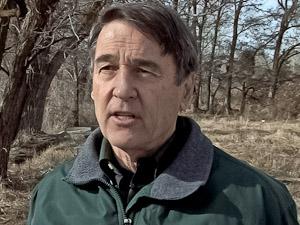
Bowler paused from behind his desk in a downtown Boise office building, where photographs and paintings of Idaho’s once-abundant salmon hang from the walls. One painting illustrates how a restored lower Snake River might look if dam removal were to occur.
“If salmon can’t flourish in central Idaho they probably can’t flourish anywhere,” he continued. “The difference between the abundance from the days of Lewis and Clark to now is just—well, it’s not even comparable.”
The Tribal Elder
Elmer Crow, Jr. wears a beaded necklace with a dangling, hand-carved pendant of a salmon around his neck. Born in 1944 in Orofino, Idaho, Crow is a Nez Perce tribal elder and one of the tribe’s fisheries biologists.
“Without salmon, personally I can’t picture life without salmon,” Crow said in an August 2010 interview in the north Idaho town of Lapwai, home to Nez Perce tribal headquarters. “We have to have salmon; that’s all there is to it.”
Crow explained that the orange beads on his necklace symbolize salmon eggs. Silver beads add light “to brighten your day.” The salmon pendant was carved from the horn of a Rocky Mountain bighorn sheep.
The Nez Perce is a tribe of 3,300 members, most of whom live on the 138,000-acre Nez Perce Reservation along the Clearwater River of northern Idaho. The original Nez Perce territory covered a large portion of central Idaho, and the tribe practiced a subsistence cycle that followed the seasons. In early spring women worked valley bottoms digging roots while men traveled to the rivers to intercept early salmon returns. Hunting continued during the salmon harvest, but to a diminished extent. Salmon and steelhead figured prominently in the tribe’s diet and traditions through the spring and summer seasons. The species figures prominently, in fact, in the Nez Perce creation story.
“Spiritually and culturally they sit very high in the Nez Perce culture and before people even got here,” Crow said. As the story goes, animals and birds were able to talk, and when humans arrived along the banks of the inland Northwest’s rivers there was certainly something to discuss.
“Coyote called a big council, and they told him: ‘We have a new animal coming, and he’s not very intelligent and he can’t take care of himself. What are we going to do?’ Salmon was the first one to raise his fin. ‘I will sacrifice my body and my flesh to make these people strong and intelligent.’ And I always look at it like: We were in trouble; the animals knew it and stepped forward to help us. Now they are in trouble; it’s our turn to step up and help them.”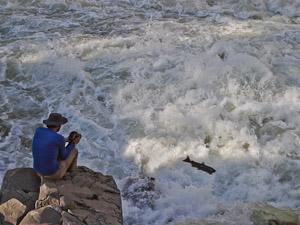
“The South Fork of the Salmon – you’ll never know the feeling we had when we went into those places,” he said. “The whole bottom of that river was pure white sand. To look down and see them, thousands of them, you couldn’t see the white sand because of the salmon bodies. It would be just black. But that was what we used to see when we was kids.”
More than 150 years ago, in the Treaty of 1855 – twenty-two years before Europeans drove the Nez Perce from their homeland and then forced them onto the reservation – the tribe signed an agreement with the United States that afforded total fishing rights on the streams and rivers within the original 13.4 million-acre reservation.
“Tribal ancestors maintained these rights because the once abundant salmon runs were vital to their way of life and future generations,” according to the tribe. “Since then, salmon and steelhead runs have declined to crisis proportions due largely to hydroelectric power developments, habitat degradation, water quality impacts, and over-harvesting.”
Today, the tribe works to recover and restore ocean-going and resident fish within its traditional range. It does this through population surveys, by initiating habitat restoration projects and by stocking streams. More importantly, perhaps, it tackles the issue in federal court. 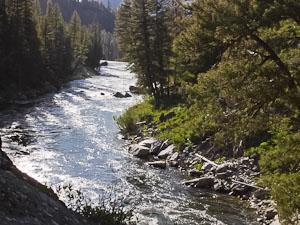
“We could make that journey a little safer, a little easier for them, knowing that they belong here” Crow said. “And why people put money before the animals, I have no idea. They belong here. They were here before we were. The spirit that these fish have is just unbelievable, you can’t describe it.”
Salmon embark on a journey that spans thousands of miles and countless perils. They overcome natural predators, diseases and the barbs and nets of men. They navigate the still waters of eight reservoirs. They work the depths of the Pacific Ocean to distances as far away as Alaska and Japan. They pass through and over eight concrete dams. And, still, some of these fish have the strength and fortitude to overcome what many men and women can only imagine. This is an easy metaphor for Crow.
“To sustain life you carry on. You go through all obstacles,” he said. “Salmon is part of your life, he’s part of your being, he’s a part of you. So take care of him.”
A Keystone Species
Tom Stuart was born in Colorado, but he’s had a life-long love affair with Idaho salmon. He has a bald head and sharp mind, and since the 1970s has maintained a home on the bank of the upper Salmon River in the hamlet of Stanley, a town of one hundred permanent residents that boasts the moniker, “Gateway to the Sawtooth Wilderness.” An avid lifelong angler and retired US Air Force aviator, Stuart talks passionately about the abundance that was and the loss he has come to know.
“This river, this Salmon River, was the most fabulous fishery I have ever encountered,” he said from the back porch of his home, where the Salmon River flowed behind his back. “It was just incredible. Steelhead in the spring. Spring chinook followed shortly thereafter, followed by these giant bull trout chasing the salmon upstream. Then summer chinook and cutthroat trout feeding on this tremendously rich food chain created by the salmon. The river was literally alive, an absolutely incredible fishery. The loss…” Stuart’s voice broke. Tears in his eyes, he looked down and held his fingers to his lips, recomposing himself. “The loss of that resource is profound,” he croaked. “It’s hurtful.” 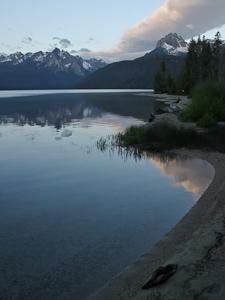
With nine hundred miles and seven thousand feet of elevation change, the rivers between the Pacific Ocean and the Sawtooth Valley constitute the longest and highest migration for salmon and steelhead in the world. In Stuart’s words these are the “Olympic champions” in the Earth’s salmon universe. They are genetically unique, engineered by nature to endure what lower-elevation coastal salmon cannot. Moreover, the ecosystem of Idaho’s high mountain valleys, so far removed from the ocean and marine nutrients, has evolved with salmon.
After returning to spawn and renew the circle of life in the exact locations of their birth, salmon die. Their bodies decompose and feed other aquatic species, insects and scavenging birds and animals. They are fundamental building blocks in the food chain in places like the upper Salmon River Valley, where glacial lakes were once home to tens and perhaps hundreds of thousands of sockeye salmon, and the rivers once teemed with countless chinook salmon and steelhead.
“Salmon bring ocean nutrients with them that feed the insects and animals that fuel the ecosystem,” said Bowler, who worked for the Idaho Department of Fish and Game for twenty-nine years and now maintains a salmon advocacy nonprofit organization called Snake River Salmon Solutions. “When salmon decline or disappear, rivers and lakes gradually become sterile, and that’s what’s happening in Idaho. The ecological importance of salmon can’t be stressed enough. Salmon are a keystone species in these rivers, where hundreds of other species, including humans, depend on what happens to salmon.”
According to a study published by the American Fisheries Society in October 1999, the link between salmon and terrestrial species has not been studied as thoroughly as the link between salmon and freshwater species. However, “recognition of salmon as a ‘keystone’ species in vertebrate communities is warranted.”
The study’s evidence suggests that many animals’ reproductive cycles and seasonal distribution are directly tied to the salmon migration. Bears and other large mammals and birds transport carcasses away from streams and rivers, and those nutrients feed trees and plants. Another study, published in 2001 in Ecology, measured the levels of marine-derived nitrogen in the vegetation near mountain streams in Alaska.
“Here we have shown that riparian plants derive a significant proportion of their foliar (nitrogen) from spawning salmon, and that riparian growth rates are significantly enhanced by this nutrient subsidy,” the study concludes. “This fertilization process may in turn affect the quality of instream spawning and rearing habitat and reproductive success of salmon populations, so that declines in spawning density may result in degraded riverine habitat and further declines in salmon production over the long term.”
The Fight for Wild Salmon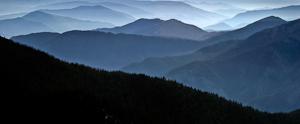
In 1993, a coalition of tribes, states and conservation groups filed suit in federal district court charging the government with failing to comply with the Endangered Species Act in its efforts to recover listed salmon. That was the first of four rounds of federal litigation that have spanned nearly twenty years. Three times a federal judge has thrown out or remanded the federal recovery blueprint for failure to do enough for wild salmon and steelhead. Four times the federal government has drafted plans that conservationists, tribes and states say did too little to recover species on the brink of extinction.
This summer should mark the conclusion of the fourth chapter in this ongoing salmon saga in the Pacific Northwest. As soon as June, Federal District Judge James Redden could rule on the Obama administration’s attempt at a recovery blueprint. Dubbed the 2010 Biological Opinion, the document has, like its predecessors, come under fire by conservation groups, the state of Oregon and the Nez Perce Tribe for failing to do enough.
“Judge James A. Redden's decision promises to be as momentous as any court-ordered environmental remedy in our lifetimes, the Dred Scott of environmental law,” wrote Oregon author Paul VanDevelder in a February guest opinion published in the Oregonian. “Of the many battles waged in the wake of the Endangered Species Act, no other beast, fish or fowl has created a more politically charged – or more expensive – fight than West Coast salmon.”
The drama, however, is not new. Its origins go back to a different time and mentality in the United States.
Following World War II, economic development and industrial growth of the Pacific Northwest were high on the minds of its residents, and after construction of the first dams on the lower Columbia River, the new settlers of the Nez Perce region sought to be part of the economic expansion. Lewiston, where Lewis and Clark once camped, was to be the center of a great Inland Empire. If dams and locks could tame the lower Snake River between Idaho and the Columbia, ships could carry wheat, paper products and other goods from the region to Portland and the global marketplace beyond.
By 1975, almost the entirety of the Columbia and Snake rivers between the Pacific and Idaho were stilled. The dams on the lower Columbia are big, and they are big power producers, too. But the four lower Snake River dams, built between 1961 and 1975, generate relatively little power at a huge cost to salmon.
Built primarily to facilitate creation of the United States’ most inland ocean port in Lewiston, the Snake dams were the result of decades of lobbying and skillful marketing by groups like the Inland Empire Waterways Association. “Cold War politics and the desire to produce nuclear weapons at the nearby Hanford facility provided additional impetus to build these power-producing dams,” Stuart said.
After decades of debate, the dams received Congressional approval and funding. Fisheries biologists found they had predicted dire consequences for salmon to an audience focused on other priorities.
Now the region is saddled with four dams that, at between 1,000 and a rarely met maximum of 2,000 megawatts – two to four percent of the consumption for an area that includes eight states and two Canadian provinces – produce relatively little power. And with goods still shipped via highway and rail, in addition to barge from the ports at Lewiston and other locations on the dammed lower Snake, the great Inland Empire has yet to arrive. 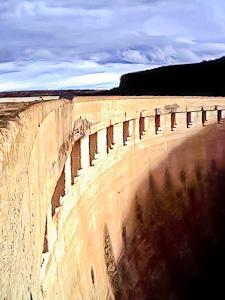
Adult salmon migrating upstream must climb stair-step ladders to get over the dams, but these barriers cause even more problems for young salmon migrating to the ocean. Baby salmon, called smolts, don’t swim. They face upstream and rely on a river’s currents to sweep them to sea. This journey from Idaho to the Pacific once took about a week on swollen spring rivers, but with eight dams and reservoirs plugging the rivers’ natural instincts, it now takes a month – if they make it at all.
“The addition of the four lower Snake River dams made the ocean-bound journey twice as treacherous for salmon,” Bowler said. “After the last dam on the lower Snake River was finished, Idaho’s wild salmon populations began a trajectory toward extinction that continues today.”
The Snake River’s coho salmon were declared extinct in 1986. In 1991, Idaho’s sockeye salmon were found in need of Endangered Species Act protection and listed as endangered. Chinook salmon were listed as threatened in 1992, and steelhead were similarly listed in 1997. Rivers that once teemed with fish so thick they bore the appearance of a walkable surface are now nearly empty, and central Idaho is increasingly bereft of a species and piece of culture that helped shape its identity. Gone is the transformative abundance that fed an entire ecosystem.
Faced with pressure to comply with the Endangered Species Act, the federal government has poured $11 billion over thirty years into projects such as retrofitting dams with fish-friendly spillways and transporting salmon around the dams in trucks and barges to try to stem their precipitous decline. Bowler said the benefits from such attempts have been slight.
Meanwhile, a 2002 Environmental Impact Statement by the US Army Corps of Engineers estimated that removing the four dams would cost about $1 billion.
For fishing and rafting outfitter Chris Swersey, who has owned Silver Cloud Expeditions in the city of Salmon since 2001, this is second-grade math.
“I feel like the way we’ve treated our fish has not been in compliance with laws that are on the books to make sure we don’t lose species like (salmon). But it’s also an example of huge economic bungling,” he said. “If you look at what it’s costing us to keep fish out of the river, it would cost us a lot less to put fish back. If I ran my business the way the government is running fish recovery, I’d be out of business in a heartbeat.”
In economic terms, the loss of salmon to communities like Lewiston, Riggins, Salmon, Tendoy and Stanley – as well as to the natural ecosystems of central Idaho – is called an externality, where competitive market prices do not reflect the full cost of producing a product. The negligible benefits of the inland ocean port at Lewiston and power produced at the four lower Snake River dams are costing rural Idaho communities millions.
“The studies that I’ve seen, and there are plenty of them out there now, say that our valley right here is missing out on anywhere from $10 to $22 million in revenue (per year),” Swersy said. “And that’s just in our little region. We’re spending a lot of (ratepayer and) tax dollars to keep communities like this from making an honest, decent living off a resource that should be able to perpetuate itself naturally. It’s a boondoggle.”
But it’s a situation that could change direction this month if the Federal District Court in Portland rules, for a fourth time, that the government’s efforts have been insufficient and forces politicians and stakeholders in the region to sit down and get serious about salmon recovery.
Tackling the Challenge of Recovery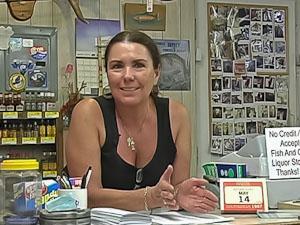
Zimmerman reflects fondly on the spring and summer of 2001, when a healthy run of hatchery-raised chinook arrived from the Pacific, having benefitted from high water on their out-going migration as babies. She views that season as an indication of what things might be like if wild, self-sustaining runs were restored.
“On a good salmon run, like back in 2001, my business tripled, easily tripled, in a matter of two and a half months,” she said. “It’s phenomenal for the town of Riggins. The restaurants, the hotels, the gas stations, all of the businesses do very well during salmon season. With salmon I am able to put money back into the community by making repairs on my building and things. I have that extra money, and I don’t have to save. It’s a big difference, a big difference for the way everybody lives.”
Zimmerman points her finger to the lower Snake River as the primary cause. It’s past time, she said, for people to consider that benefits derived from the dams would be outstripped by the far-reaching positive impacts a restored salmon fishery would bring.
“A lot of us, when we were growing up as children, we were told how wonderful dams were and ‘look what we did.’ And now they’re beginning to rethink that maybe our parents, our elders, weren’t really on top of things like they should have been.”
This isn’t cutting-edge stuff.
In his 2011 book, Recovering a Lost River, author Steven Hawley describes the mounting tide of dam removals sweeping the United States. Since 1999, more than 430 of the nation’s dams have been removed, some of them for the precise purpose of restoring salmon.
Hawley points to the Olympic Peninsula in Washington state, where work has begun to engineer removal of the 105-foot-high Glines Canyon Dam on the Elwha River. It’s a move that will restore a once-flourishing run of chinook salmon. He also points to the upper Klamath River in Oregon, where the paperwork is complete on a deal that would remove four dams and restore hundreds of miles of salmon and trout habitat. They’re only two recent examples of a movement that has already restored river health, species diversity, cultural foundations and economic fortitude to hundreds of rivers, thousands of miles of habitat and numerous communities.
“Working only with gravity and the available geography, many rivers seem to possess an uncanny ability to settle quickly and comfortably back into a channel, even after decades of diversion or impoundment,” Hawley writes. “…Fish in rivers formerly blocked by dams have in many cases rebounded far ahead of predicted schedules and, in some instances, exceeded even the most optimistic numerical predictions.”
For Zimmerman, the miracle of salmon and obvious economic boons are too precious to take for granted, and she’s perplexed more hasn’t been done to reverse their decline.
“I don’t even know why there’s a question,” she said. “I think that should be a top priority, but then I’m just a small-town girl running a tackle shop.”
Hope for Things to Come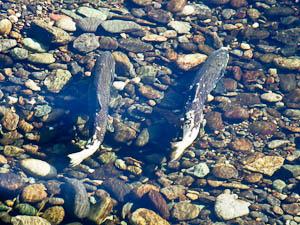
But things are different than they were in 1805. Long gone are the virile runs of wild salmon. Long gone are the ‘salmon eaters,’ the Shoshone Indians, who now live on the Fort Hall Reservation in southeast Idaho. And long gone are the multitude of anglers who bolstered business while in pursuit of a prized forty-pound fish.
But the valleys and mountains of the upper Salmon River and its tributaries still resonate with the mystery of the rugged, wild and untamed. Big sweeps of sagebrush give way to the deep green of forested mountainsides, which are broken by deep, rocky canyons where rivers flow clear, clean and cold.
It’s country that inspires Anglin, for one, and her appreciation for her home affords a window into its potential.
“This is my special place,” she said. “I love everything about it. I wish we could have the salmon like they used to be. I hope that we can get the salmon back and have open season here again. I would love it. And I think maybe they will in years to come.”
Photos are copyright protected and may not be reproduced without permission. Copyright information for the photos are as follows: (1) Little Redfish Lake, photo courtesy of Greg Stahl; (2) Viola Anglin, photo courtesy of Idaho Rivers United; (3) Stanley Sunrise, photo courtesy of Greg Stahl; (4) Bert Bowler, photo courtesy of Idaho Rivers United; (5) Neil Salmon Dagger Falls, photo courtesy of Greg Stahl; (6) Middle Fork, photo courtesy of Greg Stahl; (7) Redfish Lake, photo courtesy of Greg Stahl; (8) Upper Salmon Canyon, photo courtesy of Greg Stahl; (9) “Salmon Dam” is copyright protected through Flickr Creative Commons Attribution License 2.0 Generic and may not be reproduced without permission. Photo is courtesy of Josh Parrish. (10) Rexann Zimmerman, photo courtesy of Idaho Rivers United; (11) Photo of Chinook salmon is copyright protected through Flickr Creative Commons Attribution License 2.0 Generic and may not be reproduced without permission. Photo is courtesy of the US Fish and Wildlife Service, http://www.flickr.com/photos/usfws_pacificsw (12) Greg Stahl bio photo, courtesy of Greg Stahl.
REFERENCES
i Bert Bowler, fisheries biologist. Interview by Greg Stahl. Boise, Idaho. April 26, 2011.
Bowler explained that two percent is widely accepted among fisheries biologists. The estimate is based on an average of 50,000 returns of spring/summer chinook and steelhead to the Snake River Basin, divided by 2.5 million, the estimated number of historic returns.
ii Meriwether Lewis and William Clark. The Journals of Lewis and Clark. (Whitefish, Montana, Kessinger Publishing, LLC, N.p.)170.
iii Johnny Carrey and Cort Conley. River of No Return. (Caimbridge, Idaho, Backeddy Books, 1978), 22-23.
iv Marmorek, D.R., C.N. Peters and I. Parnell (eds.) PATH final report for fiscal year 1998. (Vancouver, BC, ESSA Technologies Ltd., December 16, 1998), 263.
and Jeff Abrams, Senior Fisheries Technician, Boise, and 117 additional scientists, to Commerce Secretary Gary Locke, August 20, 2009, U.S. Department of Commerce, 1401 Constitution Aveenue, NW, Washington, DC 20230.
v Nez Perce Tribe. "Frequently Asked Questions." Available at www.nezperce.org/history/frequentlyaskedq.htm (Accessed April 5, 2011).
vi Nez Perce Tribe Department of Fisheries Resources Management. "Protecting and Conserving Our Way of Life." Available at www.nezperce.org (Accessed April 5, 2011).7.
vii C. Jeff Cederholm, Matt D. Kunze, Takeshi Murota, and Atuhiro Sibatani. "Pacific Salmon Carcasses: Essential Contributions of Nutrients and Energy for Aquatic and Terrestiral Ecosystems," Fisheries, Vol. 24, No. 10. (October 1999): 10.
viii James M. Helfield, Robert J. Naiman. "Effects of Salmon-Derived Nitrogen on Riparian Forest Growth and Implications for Stream Productivity," Ecology, Vol. 82, No. 9 (September 2001): 2408.
ix Paul VenDevelder. "The reckoning: A looming decision on endangered salmon will set the stage for momentous battles over the future," The Oregonian (February 12, 2011).
x Keith C. Petersen. River of Life, Channel of Death: Fish & Dams on the Lower Snake. (Portland, Oregon. Oregon State University Press, 2001), 87-97.
xi Keith C. Petersen. River of Life, Channel of Death: Fish & Dams on the Lower Snake. (Portland, Oregon. Oregon StateUniversity Press, 2001), 97.
xii Northwest Power Pool. "Reliability through Cooperation," April 30, 2008. Available at www.nwd-wc.usace.army.mil/(Accessed April 27, 2001).States included in the Northwest Power Pool are Washington, Oregon, northern California, Idaho, Montana, Utah, Nevada and western Wyoming. Provinces include parts of British Columbia and Alberta. The pool's production is about 50,000 megawatts divided by the lower Snake River dams' production of 1,000 to 2,000 megawatts, a figure of two to four percent is appropriate.It is worth pointing out, however, that the dams' generally produce far less than 2,000 megawatts and in fact produce less than 500 megawatts, or less than 1 percent, in the month of August, when demand for electricity is highest.
xiii Keith C. Petersen. River of Life, Channel of Death: Fish & Dams on the Lower Snake. (Portland, Oregon. Oregon State University Press, 2001), 148.
xiv C. E. Petrosky and H.A. Schaller. "Influence of river conditions during seaward migration and ocean conditions on survivalrates of Snake River Chinook salmon and steelhead," Ecology of Freshwater Fish (2010): 6.
xv U.S. Army Corps of Engineers. "Final Lower Snake River Juvenile Salmon Migration Feasibility Report/Environmental Impact Statement," (February 2002).
xvi. Don C. Reading. "The Potential Economic Impact of Restored Salmon and Steelhead Fishing in Idaho," (Boise, Idaho, Ben Johnson Associates, Inc., February 2005), 22.
xvii Steven Hawley. Recovering a Lost River: Removing Dams, Rewilding Salmon, Revitalizing Communities. (Boston, Massachusetts. Beacon Press, 2011), 5.
xviii Steven Hawley. Recovering a Lost River: Removing Dams, Rewilding Salmon, Revitalizing Communities. (Boston, Massachusetts. Beacon Press, 2011), 7.